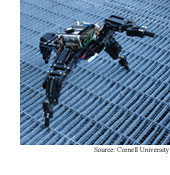
|
November
27/
December4, 2006
 |
|
|  |
|
NEWS
|
Robot deals with damage
 A four-legged robot that maintains an awareness
of itself is able to adapt to damage by recognizing what
has changed and altering its gait to compensate. Robots
that adapt to unexpected changes are important in places
where human repair crews can't get at damaged robots,
especially in remote and hazardous environments like outerspace.
(Resilient
Machines through Continuous Self-Modeling, Science,
November 17, 2006)
A four-legged robot that maintains an awareness
of itself is able to adapt to damage by recognizing what
has changed and altering its gait to compensate. Robots
that adapt to unexpected changes are important in places
where human repair crews can't get at damaged robots,
especially in remote and hazardous environments like outerspace.
(Resilient
Machines through Continuous Self-Modeling, Science,
November 17, 2006)
Shape shifter expands repertoire
A polymer material changes shape twice in response
to external stimulation like heat or light, morphing from
an initial shape to a second shape and then a third. The
material could be used in medical devices, for example
stents that need to be one shape for insertion, another
shape for use and a third shape for removal. (Polymeric
Triple-Shape Materials, Proceedings of the National
Academy Of Sciences, published online November 20,
2006)
Spiky surface kills bugs
A plastic material that forms microscopic spikes
on surfaces kills bacteria and viruses on contact. The
material could be used as a coating that helps curb the
spread of infections in hospitals. (Polymeric
Coatings That Inactivate Both Influenza Virus and Pathogenic
Bacteria, Proceedings of the National Academy Of
Sciences, November 21, 2006)
Nanoparticles flag cocaine
A simple, rapid test comparable to pH strips detects
substances like cocaine in blood samples. The strips contain
gold nanoparticles bound into clumps by short DNA strands
that release the nanoparticles in the presence of cocaine-specific
molecules. The free nanoparticles collect at a barrier
on the strip, producing a visible red line. The technique
could be applied to rapidly detecting all sorts of substances
for medical diagnosis and environmental monitoring. (A
Simple and Sensitive "Dip-Stick" Test in Serum Based on
Lateral Flow Separation of Aptamer-Linked Nanostructures,
Anglewandte Chemie International Edition, published
online November 9, 2006)
Double-duty nanocrystals
Nanocrystals made of iron cobalt surrounded by
a shell of graphite are highly magnetic and readily absorb
infrared light. This makes them useful for both diagnosing
and treating disease because they can serve as a contrast
agent in magnetic resonance imaging and as a substance
that can be heated inside the body to kill diseased cells
and tissue. (FeCo/Graphitic-Shell
Nanocrystals as Advanced Magnetic-Resonance-Imaging and
Near-Infrared Agents, Nature Materials, published
online November 19, 2006)
Nanotubes move heat uphill
Nanotubes stuffed with more molecules at one end
than the other can conduct heat in the wrong direction,
from warm to warmer rather than the usual warm to cold.
The nanotubes could be used to cool computer chips, make
refrigerators without gases or compressors, and reduce
the costs of heating and cooling buildings. (Solid-State
Thermal Rectifier, Science, November 17, 2006) |
FEATURES
|
View
from the High Ground: ICL's John Pendry
Physics as machine tool, negative refractive
index, metamaterials, shattered wine glasses, higher capacity
DVDs, scientific backwaters, risk perception and practice,
practice, practice.
|
How
It Works: Quantum computing: qubits
Photons, electrons and atoms, oh my! These particles are
the raw materials for qubits, the basic building blocks
of quantum computers. |
|
 |
News RSS feed 
Blog RSS feed 
Bookshelf RSS feed

New: TRN's
Internet Services
TRN's Jobs Center
|
| |
|
| |
|
| |
"Physics
is to the rest of science what machine tools are
to engineering. A corollary is that science places
power in our hands which can be used for good or
ill. Technology has been abused in this way throughout
the ages from gunpowder to atomic bombs."
- John Pendry, Imperial College London |
|
| |
|
| |
Thanks
to Kevin from
GoldBamboo.com
for technical support |
|

